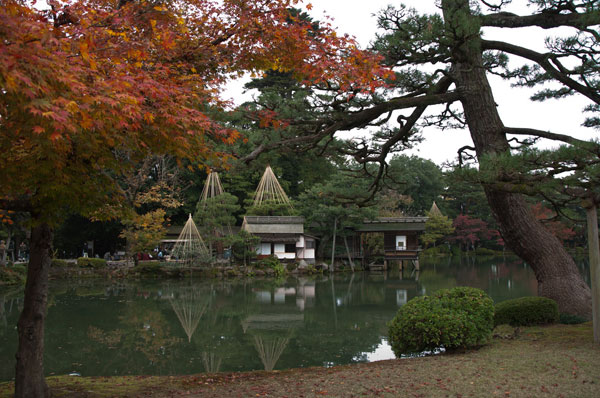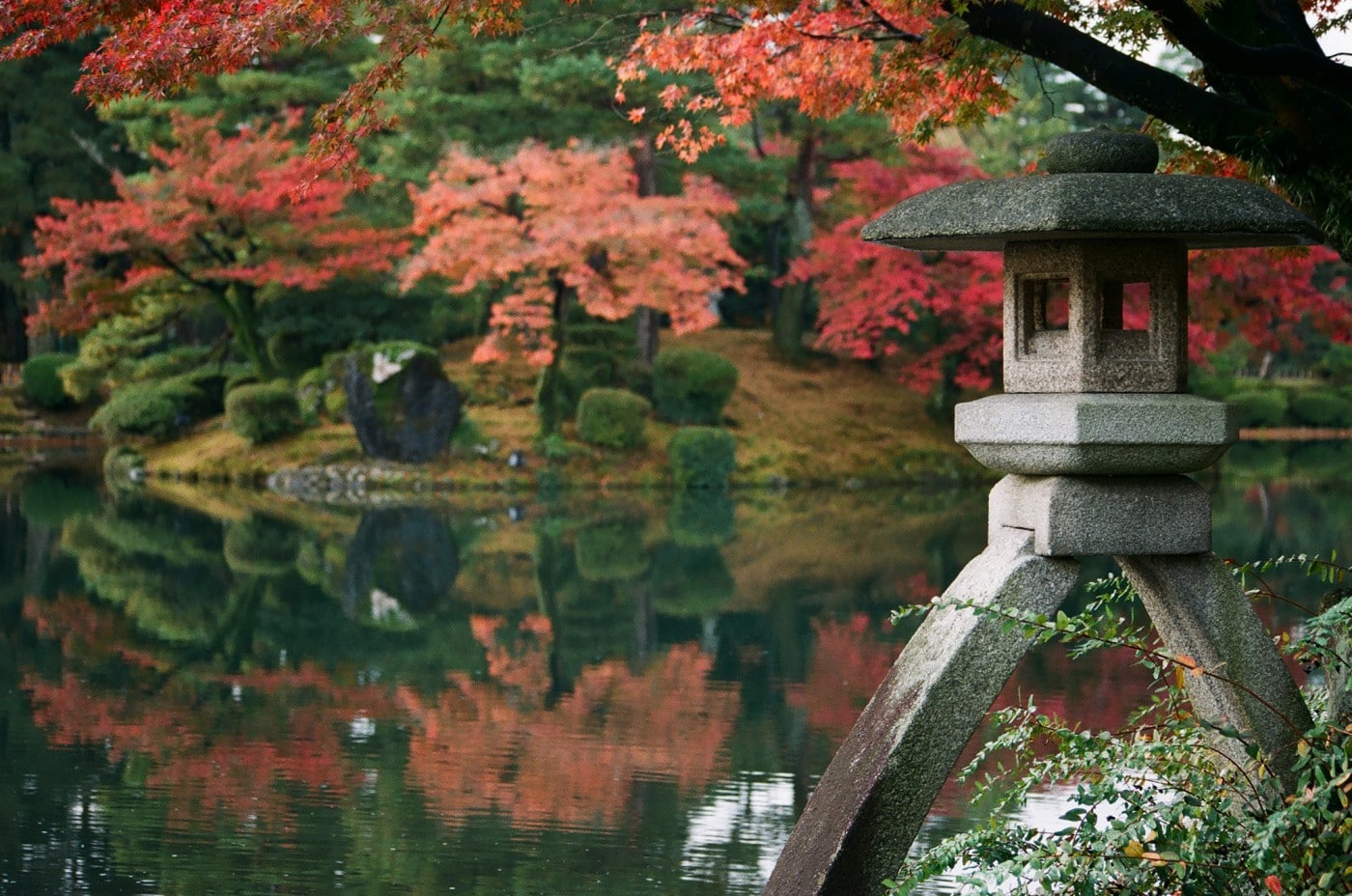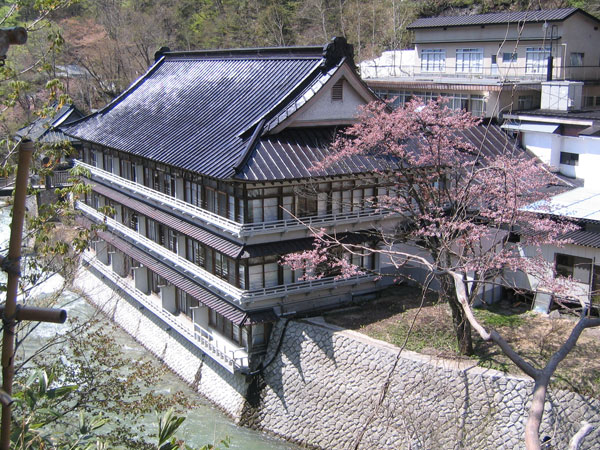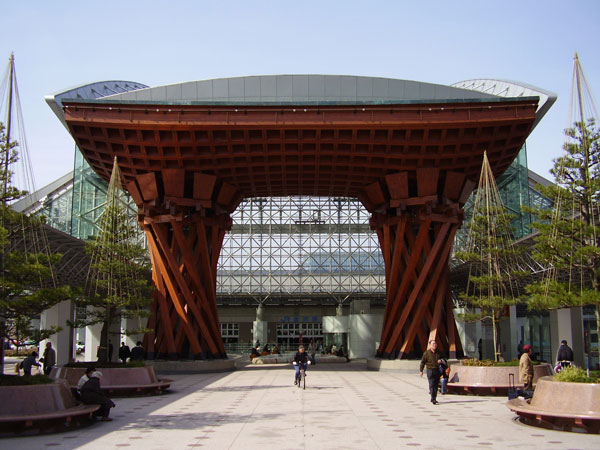Samurai Central
On the Sea of Japan, northwest of Tokyo, lies the serene, mountainous region known as Ishikawa. With its pristine coast and remote villages, Ishikawa offers a respite from life’s stressors.
 Ishikawa is easily reached by plane or car, but the most romantic way to get there is on the Shinkansen train which passes by Mount Fuji, visible if you are fortunate for nearly an hour before arriving. When heading towards Ishikawa, reserve a seat on the right side of the train facing north and when returning to Tokyo, reserve the south facing left side. The big city in Ishikawa, which must not be missed, is Kanazawa, a modern place of shops selling the gold leaf chachkas for which the region is known, as well as terrific restaurants offering delicious seafood. The two best reasons for coming here are to wander through Kenrokuen Gardens and later to see the well preserved samurai section of town. The Gardens, which exemplify the six elements required for perfection in landscaping, is regarded by connoisseurs as one of the three most beautiful in Japan. The elements are: spaciousness, seclusion, artificiality, abundant water, antiquity, and broad views. Indeed, as one strolls through the gardens over its footbridges, beside its ponds, and beneath its many varieties of trees, the amalgamation of these elements creates a divine and therapeutic effect on the senses no matter what season you are in.
Ishikawa is easily reached by plane or car, but the most romantic way to get there is on the Shinkansen train which passes by Mount Fuji, visible if you are fortunate for nearly an hour before arriving. When heading towards Ishikawa, reserve a seat on the right side of the train facing north and when returning to Tokyo, reserve the south facing left side. The big city in Ishikawa, which must not be missed, is Kanazawa, a modern place of shops selling the gold leaf chachkas for which the region is known, as well as terrific restaurants offering delicious seafood. The two best reasons for coming here are to wander through Kenrokuen Gardens and later to see the well preserved samurai section of town. The Gardens, which exemplify the six elements required for perfection in landscaping, is regarded by connoisseurs as one of the three most beautiful in Japan. The elements are: spaciousness, seclusion, artificiality, abundant water, antiquity, and broad views. Indeed, as one strolls through the gardens over its footbridges, beside its ponds, and beneath its many varieties of trees, the amalgamation of these elements creates a divine and therapeutic effect on the senses no matter what season you are in.
In the city itself, the samurai section provides ample evidence of the authority of the community that had a hand in creating and preserving the gardens. It doesn’t take much imagination to picture yourself a lord, warrior, geisha, guest, or supplicant, acting out a well-defined role in medieval Japan as you wander narrow, stone streets surrounded by high, yolk colored walls. The best time to be here is at night when the glow of street lamps adds drama and shadows to what is seen.
The prefecture holds rural delights as well. Among the most spectacular sights is the Kakusenkei Gorge. It’s here that the seventeenth century poet Basho spent time composing his thoughts, meditating, and writing work that is modern, whimsical, and powerfully observant, such as this poem, entitled, “Wrapping Dumplings.”
Wrapping dumplings in
bamboo leaves, with one finger
she tidies her hair
Hashi means “bridge,” in Japanese and spanning the gorge are three hashi that might inspire your thoughts as you crisscross – Korogi, Ayatori, and Kurotani. Each has its own character with the first an onomatopoeia meaning, “cricket,” the second meaning, “cat’s cradle,” and the third, “black valley.” The bridges are radically different in appearance from each other with Korogi arched and seemingly ready to jump like a cricket; Ayatori a web of beams that resemble the strings of a cat’s cradle; and Kurotoni modern and powerful, a controversial attempt to demonstrate mastery over nature rather than integration with it.
Japan is a nation where being fit is second nature for most people, a factor which contributes to the impressive longevity of its citizens. Ishikawa, like most prefectures, is a place of walking, cycling, and wandering. At the same time the Japanese have a long history of activities that allow one to unwind. So, after wandering parks, walking the streets, and hiking or cycling its gorges take part in quiet aesthetic. A great place to start is the Ishikawa Kutaniyaki Art Museum, in Kaga, where a stunning collection of crockery, pottery, and lacquerware used for ceremony and daily life is on display. What’s fascinating, too, is the relationship between the old or traditional forms of art and what’s used today. The work at the museum inspires the same products found at kaiseki meals, the multi-course, seasonally driven dining experiences that Japan has perfected.
Should you wish to have beautiful art in your home, you can visit private, artisanal studios and see the work being refined. One of the best lacquerware studios is Koubou Senju in Yamanaka. It is here that the owner, his wife, and two sons demonstrate a commitment to the art of woodworking that sustained the Japanese aesthetic for centuries. These artists’ appreciation for nature and craft is of the highest order and the greatest difficulty you may have is choosing just one or two of the examples shown as each will have a profound effect on the senses. What I love about the bowls, cups, and plates made here are the ways in which hollow space is used. Like Henry Moore’s sculptures, the crafts suggest and imply that what is unseen such as emotions and thoughts are more powerful than what is right in front of us and what is known about ourselves. The work has a psychological importance since it inspires us to reconsider our souls in timeless fashion.
Another way that time stands still in Japan is through the ryokans or traditional inns. Here guests remove shoes at the entrance and get out of their ordinary clothes, putting on yakata (robes). They then do nothing for days and nights besides dozing on tatami mats, taking hot baths in natural hot springs in full view of forests and eating two meals a day made up of simple, delicious, local products so seasonal that some of them are available for less than a week. The ryokans allow you to indulge the senses through an appreciation for silence. It’s in this way that the Japanese have devised a way to turn back the clocks, to be young again, and to see the world with innocence, rather than experience, which to me is a kind of creative magic needed now more than ever.
The aesthetic of Japan is evident in its appreciation for nature and the ability of its people to appreciate the fleeting nature of life. Through a feeling for the ephemeral implicit in their love for seasonality, the unseen, and the unknowable, the Japanese have developed a strong sense of acceptance for the briefness of life. What Ishikawa does best is to preserve that sense of loss while allowing us to enter its proud and complex history. In Ishikawa, the blend of the new and old is startling at times and yet soothing. From the art to the inns, this is a region worth exploring. By discovering what is here, you may learn more about yourself as well which, after all, is the point of traveling.
The area code for Japan is 81.
Where to Stay:
Ana Hotel Kanazawa – In the center of town, sleek, modern and with great service; within walking distance of everything you need. 16-3 Showa-Machi; (076) 224-6111. www.ichotelsgroup.com
The Kayotei – A flat out astonishing property that takes luxury to a new level with only 10 rooms, the finest kaiseki food in Japan, and very amiable and sophisticated owners.
81-761-78-1410; 20-HO, 1-Chome Higashi-machi, Yamanaka onsen, Kaga-shi, Ishikawa-ken 922-0114;www.kayotei.jp
Beniya Mukaya – Run by a couple who are both traditional and outgoing, this ryokan, a member of Relais & Chateaux, has delightful and delicious food. 761-77-1340; 55-1-3 Yamashiro onsen, Kaga Ishikawa Prefecture 922-0242, Japan; beniya@mukayu.com
Where to Eat:
Kitami – the old Japan is here. Dine while seated on tatami mats. Traditional and, as usual, seasonal. Kanazawa City; 076/261-7176.
Kotobuki-Ya – Japan has a long tradition of serving first rate vegetarian food known as shojin ryori, and if you have never experienced how flavorful a meal of small dishes can be, now is the time. -Kanazawa City; 076/231-6245; 2-3-13 Owari-cho, Kanazawa, Ishikwawa Prefecture 920-0902, Japan
Miyoshian – strolling the Kenrokuen Gardens stimulates the appetite and this restaurant, inside the gardens, will satisfy your hunger. The restaurant serves traditional, regional cuisine, and is open for lunch and dinner with set menus with prices varying according to the number of dishes served. 076/221-0127; 1-11 Kenroku machi, Kanazawa, Ishikawa Prefecture 920-0936, Japan
Kanazawa Station – it ain’t Penn Station. Inside the large train station are a great variety of typical, simple restaurants offering well priced and delicious versions of yakitori, tempura, and ramen. 1-1 Kinoshinbo machi, Kanazawa, Ishikawa Prefecture
*When at the ryokans, breakfast and dinner is included. Skip lunch and meditate on your next meal instead!
Nightlife:
Mokkiriya – located in Tatemachi. Great place to hear live music with locals. 076-231-0096
Kuro-ya – located in the Honmachi section, this is a first-rate example of a Japanese pub or izakaya. 076-262-0940
Higashi-Chayamachi District – a small section of wood frame teahouses, any one of which is worth visiting, to participate in an authentic tea ceremony.
What To See and Do:
You must visit the Kenrokuen Gardens, see the Kakusenkei Gorge, visit the Ishikawa Kutaniyaki Art Museum, and try to book a night at a ryokan. The ryokan experience is profound and deeply memorable – nothing like it anywhere else in the world!




